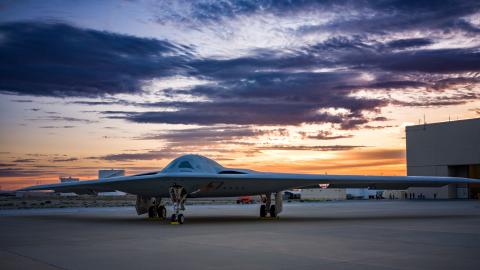For the first time in history, the United States faces two major nuclear adversaries—the Russian Federation and the People’s Republic of China. These authoritarian countries, along with rogue states Iran and North Korea, seek to undermine the United States and replace the US-led order with one dominated by the PRC and its authoritarian partners. The threat environment is far more complex, tense, violent, and dangerous than a “competition” between states. It is a rivalry between adversaries. The PRC and its partners are engaging in a new cold war, which the United States is trying to prevent from going hot.
Russia preceded its unprovoked full-scale invasion of Ukraine with a nuclear exercise,1 and has continued to engage in nuclear saber-rattling to deter the United States and its allies from giving Ukraine what it needs to prevail. Moscow, which has an extensive record of cheating on arms control agreements, is no longer abiding by the New START Treaty.2 And while Russia has been focused on its war against Ukraine, it is also nearing the completion of its nuclear recapitalization program.
The PRC is expanding and improving its nuclear capabilities. According to Pentagon officials, the PRC now possesses more land-based intercontinental ballistic missile (ICBM) launchers than the US. Additionally, the PRC is investing heavily in theater systems with lower yield and precision accuracy; hypersonic glide vehicles, which are difficult to maintain and track, and whose intended destination is difficult to assess; and the highly provocative fractional orbital bombardment system (FOBS).3On top of this, the PRC has formidable anti-access/area denial (A2/AD) capabilities, which would make it difficult for the United States to project power in the event of a war in the Pacific.4
Making matters even more concerning, the PRC and Russia are increasingly collaborating to undermine the United States and US interests, including in the nuclear sphere. The Pentagon has publicly confirmed that Moscow is assisting Beijing’s capacity to produce nuclear warheads.5
North Korea remains a rogue nuclear nation. It continues its record-breaking missile launches, flouting international demands that it ceases its illicit nuclear missile program. Meanwhile, Iran is a nuclear threshold nation and the world’s leading sponsor of terrorism. The regime in Tehran conceals the extent of its nuclear program, using this ambiguity to extort the international community for economic gain. The North Korean and Iranian regimes have materially aided Russia’s war in Ukraine and indicated support for the PRC’s malign behavior.
US allies are understandably made uncomfortable by the risk that the authoritarian, expansionist powers in their geographic regions will use nuclear coercion to deter the United States from coming to their defense. But an even greater threat is that an expansionist power could cross the nuclear threshold in an otherwise regional war that begins as a limited and conventional conflict. Some allies are asking for more initiatives to bolster the credibility of American nuclear assurances.6 But the US also needs to do more to deter conventional war. This is an imperative step to prevent adversaries from going down the paths of escalation that lead to a larger scale war—including crossing the nuclear threshold or launching a conventional attack of strategic consequence, such as attacking US territories or the US mainland.
To deter China, Russia, and rogue nations—and reassure allies—it is imperative that the United States complete its planned nuclear modernization program; however, because this program was designed and initiated in 2009, it is no longer sufficient to deter both Russia and the PRC. At the time, the PRC was considered a “lesser included case.” As policymakers seek to adapt and build on the US strategic deterrent, the sixth-generation B‑21 bomber—the first strategic bomber to join the fleet in decades—comes at a pivotal moment.
When Secretary of Defense Lloyd Austin introduced the B‑21 at its unveiling in December 2022, he led by telling of the bomber’s namesake.7 Four months after the Imperial Japanese struck Pearl Harbor, 16 US Army bombers took off from an aircraft carrier in the Pacific. The “Doolittle Raiders,” led by Lieutenant Colonel Jimmy Doolittle, impressed the world by demonstrating American airpower’s long reach. The successful strike boosted the morale of the United States and signaled American formidability and resolve.
The stealthy B‑21 Raider is suited to do the same things now in this high-stake new cold war. It will signal American formidability and resolve to defend the US-led order that the first Raiders built and which the United States has to defend. The B‑21 Raiders will play an integral role against nuclear peer adversaries, both of whom possess advanced air defenses. The B‑21 will eventually replace both the nuclear-capable B‑2 Spirit and conventional-only B‑1B Lancer. Only the B‑52H, which has been in the US inventory since the 1960s, will complement the B‑21 until at least 2040. Though the B‑52H is not stealthy, it remains suited to launch long-range standoff weapons. But the B‑21’s original planned fleet size of 100, like the rest of the program of record, which was decided a decade ago, is insufficient to maximize the credibility of deterring both nuclear peers simultaneously.
The aim of this compilation and the associated panel discussion is to assess the attributes and benefits of the Raider and its applicability to this new complex threat environment. While each expert addresses different aspects of the Raider and each essay stands on its own, six themes emerged across the studies.
The following points are the editor’s views and may be shared by the essayists but are not meant to be understood as a consensus summary.
- The B‑21’s flexibility makes it essential for holding at risk the growing number of Russian and Chinese conventional and strategic weapons, regime facilities, and other objects hidden deep in adversary territory, which is a necessary capability to meet US nuclear deterrent requirements. The B‑21 has a unique role in nuclear deterrence, as it can carry a large payload of either nuclear or conventional munitions. The bomber’s long range, aided by aerial refueling, gives it a significant advantage and makes it vital to meeting the challenge of deterring two major nuclear powers. The bomber force can be dispersed or placed on airborne alert to improve its survivability during a crisis. This differs from the deterrent role of submarine-launched ballistic missiles (SLBMs) and ICBMs, as the US can deploy bombers in theater to demonstrate resolve while also communicating restraint by withholding the employment of their nuclear weapons. Without the B‑21, America’s adversaries would have a far simpler risk calculation. For example, the Chinese Communist Party (CCP) has obscured some of the objects it values far from its shores and behind significant defenses. The B‑21’s long-range penetrating strikes ensure these defensive measures offer the adversary no sanctuary, thereby bolstering the credibility of US deterrence.
- The B‑21 has tremendous warfighting potential against highly sophisticated defenses, which will be vital if deterrence fails and peer adversaries choose war with the United States. The Raider embodies decades of advances in stealth technologies, which are expected to have far outpaced advances in defensive systems.8 This is essential to winning a war with China. Many of the PRC’s high-priority targets are deep inside Chinese territory and protected by advanced air defenses. The B‑21’s stealth would deny even peer adversaries like China or Russia the critical information they need to neutralize the bomber. Bomber pilots can also adapt and change targets during a mission, giving the B‑21 an advantage against time-sensitive and mobile targets. The B‑21 can deliver large payloads accurately and in a timely manner to gain the initiative and halt an aggressive campaign against US troops or allies. The B‑21 provides flexibility, both mission flexibility (it can be equipped with a variety of payloads) and operational flexibility (it can be operated from a range of bases and locations). This flexibility is hugely advantageous for US planners. It will also have the ability to interdependently target, assess damage, and possibly react as required.
- A sufficiently large fleet of B‑21s would bolster assurance of allies and deterrence against nuclear peer adversaries, even while some bombers are engaged in missions against other adversaries. If the US fleet of conventionally and nuclear-armed B‑52Hs and B‑21s is sufficient in quantity, the US will have indispensable tools to deter one adversary from crossing the nuclear threshold and assure allies during competition and conflict, while at the same time carrying out conventional penetration and standoff strike operations against another peer like China or Russia. The United States should employ a mixed bomber fleet that can carry out a conventional campaign with a nuclear backstop in one theater while simultaneously maintaining nuclear deterrence and assurance in another theater.
- The B‑21’s unique attributes enable it to enhance US nuclear assurances across the globe. The B‑21 is a visible signal of American commitment to allies. Notably, allies in regions without persistent US forward-deployed strategic forces are likely to appreciate that the B‑21 has an extended range and can loiter for a long period of time. Allies can also participate in the bomber mission, as discussed in greater depth by one of the expert essayists. It could operate from many different places, including from an ally providing refueling (for example, Japan or South Korea) or basing (possibly Australia.)
- The costs to operate and sustain (O&S) the B‑21 are comparable to other manned planes. Policymakers can make decisions now to optimize the Raider’s advantages and lower the cost per plane. According to independent analysis, more than any other factors, O&S costs for all manned aircraft directly correlate with the size of the fleet.9 There are two significant implications of this. One, the B‑21’s stealth does not mean that it will carry a similar operating cost to the famously pricey B‑2 Spirit. The Air Force operates only 21 B‑2s but intends to procure more than 100 of the cheaper B‑21s.10 Two, increasing the size of the B‑21 fleet beyond the floor of 100 would drive down the O&S costs per plane.11
- For the B‑21 force to be able to deter two major powers or to engage in a major power war while simultaneously deterring opportunistic aggression in another theater, the US will require more than 100 of the bombers. Washington should immediately begin planning to produce more and assess additional basing space. The US Air Force has confirmed that 100 B‑21s is the minimum order, not the maximum.12 The original number, 100, was selected before the US realized that it would need to deter China and Russia simultaneously, and the PRC’s number of strategic systems has rapidly grown since then. Several of the other expert essayists in this report noted this conclusion as well. The Center for Strategic and Budgetary Assessments recommends that the US plan to construct a force capable of defeating two major powers simultaneously and suggests that the US procure 288 B‑21s for this purpose.13A prominent former national security official projected the number to range from 300–400.14 Washington should conduct an updated study to assess the growing target set and provide a new assessment of the necessary fleet size. As a starting point, the US should plan to acquire at least double the original number of planes. Congress should be aware of the need for more B‑21s so that it can adjust funding and plan for additional production.
Washington faces a great challenge to the US-led international system of alliances—a system that has benefited Americans, as well as US partners and allies, since the Second World War. The stakes are high, and the US urgently needs to make changes to its strategic posture to protect this system. Taking full advantage of the B‑21 Raider—and planning now to significantly expand the size of the fleet—is one such change.




















